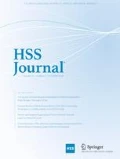Abstract
Background
Patellar Clunk Syndrome is a painful condition associated with a mechanical catching or clunking during active extension following total knee arthroplasty (TKA). The syndrome is caused by growth of interposing soft tissue usually at the superior pole of the patella. This interposed soft tissue cannot be visualized on plain radiographs.
Questions
The aim was to ascertain if magnetic resonance imaging (MRI) would prove helpful in confirming the clinical diagnosis of patellar clunk by visualizing the interposed soft tissues adjacent to the patella and that the recognition of this tissue would be highly reproducible.
Methods
MRI scans of 12 patients with clinical suspicion or related symptoms of a patellar clunk syndrome following primary TKA were retrospectively evaluated. Size of soft tissue masses proximal to the patella were determined in sagittal and axial MRI views. Largest diameters were recorded in two dimensions by two independent observers, and interobserver reliability was determined by intra-class correlation coefficients (ICC).
Results
Nine patients (75%) showed obvious MRI findings consistent with a patellar clunk lesion with high interobserver reliability (ICC values >0.75). In eight patients, this lead to operative treatment with arthroscopic debridement.
Discussion
MRI helps confirm the clinical diagnosis of patellar clunk. The data indicate that MRI is effective in defining the soft tissue lesion that is implicated in clinically evident patellar clunk syndrome after TKA.


Similar content being viewed by others
References
Beight JL, Yao B, Hozack WJ, Hearn SL, Booth RE, Jr.: The patellar "clunk" syndrome after posterior stabilized total knee arthroplasty. Clin Orthop Relat Res 1994(299): 139–42.
Carpenter RD, Brilhault J, Majumdar S, Ries MD. Magnetic resonance imaging of in vivo patellofemoral kinematics after total knee arthroplasty. Knee 2009; 16(5): 332–6.
Figgie HE, 3 rd, Goldberg VM, Heiple KG, Moller HS, 3 rd, Gordon NH: The influence of tibial-patellofemoral location on function of the knee in patients with the posterior stabilized condylar knee prosthesis. J Bone Joint Surg Am 1986; 68(7): 1035–40.
Hozack WJ, Rothman RH, Booth RE, Jr., Balderston RA: The patellar clunk syndrome. A complication of posterior stabilized total knee arthroplasty. Clin Orthop Relat Res 1989(241): 203–8.
Insall JN, Binazzi R, Soudry M, Mestriner LA: Total knee arthroplasty. Clin Orthop Relat Res 1985(192): 13–22.
Insall JN, Lachiewicz PF, Burstein AH: The posterior stabilized condylar prosthesis: a modification of the total condylar design. Two to four-year clinical experience. J Bone Joint Surg Am 1982; 64(9): 1317–23.
Lee KY, Slavinsky JP, Ries MD, Blumenkrantz G, Majumdar S: Magnetic resonance imaging of in vivo kinematics after total knee arthroplasty. J Magn Reson Imaging 2005; 21(2): 172–8.
Mosher TJ, Davis CM, 3 rd: Magnetic resonance imaging to evaluate osteolysis around total knee arthroplasty. J Arthroplasty 2006; 21(3): 460–3.
Potter HG, Foo LF: Magnetic resonance imaging of joint arthroplasty. Orthop Clin North Am 2006; 37(3): 361–73, vi-vii.
Raphael B, Haims AH, Wu JS, Katz LD, White LM, Lynch K: MRI comparison of periprosthetic structures around zirconium knee prostheses and cobalt chrome prostheses. AJR Am J Roentgenol 2006; 186(6): 1771–7.
Sharkey PF, Hozack WJ, Rothman RH, Shastri S, Jacoby SM: Insall Award paper. Why are total knee arthroplasties failing today? Clin Orthop Relat Res 2002(404): 7–13.
Simison AJ, Noble J, Hardinge K: Complications of the Attenborough knee replacement. J Bone Joint Surg Br 1986; 68(1): 100–5.
Sofka CM, Potter HG, Figgie M, Laskin R: Magnetic resonance imaging of total knee arthroplasty. Clin Orthop Relat Res 2003(406): 129–35.
Vernace JV, Rothman RH, Booth RE, Jr., Balderston RA: Arthroscopic management of the patellar clunk syndrome following posterior stabilized total knee arthroplasty. J Arthroplasty 1989; 4(2): 179–82.
Vessely MB, Frick MA, Oakes D, Wenger DE, Berry DJ: Magnetic resonance imaging with metal suppression for evaluation of periprosthetic osteolysis after total knee arthroplasty. J Arthroplasty 2006; 21(6): 826–31.
Acknowledgements
This work was initiated and inspired by Dr. Richard S. Laskin who passed away in 2008. The authors dedicate this work to his remembrance.
The authors would like to thank Dr. Nina Timmesfeld from the Institute for Medical Biometry and Epidemiology, Marburg, Germany for her support with statistical analysis. The authors also thank Ed O'Connell and Tina Miller (Office Managers, HSS) for their warm, efficient, and rapid support.
Disclosures
The study was performed at the Hospital for Special Surgery, New York, NY, USA. Steven B. Haas, MD receives royalties from and is a consultant to Smith & Nephew. Thomas J. Heyse, MD is a consultant to Smith & Nephew. Institutional research support is granted by GE Healthcare and NIH. Hollis Potter, MD is a consultant to Biomet.
Each author certifies that his or her institution has approved the reporting of these cases, that all investigations were conducted in conformity with ethical principles of research, and that informed consent for participating in the study was obtained.
Author information
Authors and Affiliations
Corresponding author
Additional information
Level of Evidence: Level IV: Retrospective Case Series
Rights and permissions
About this article
Cite this article
Heyse, T.J., Chong, L.R., Davis, J. et al. MRI Diagnosis of Patellar Clunk Syndrome Following Total Knee Arthroplasty. HSS Jrnl 8, 92–95 (2012). https://doi.org/10.1007/s11420-011-9258-4
Received:
Accepted:
Published:
Issue Date:
DOI: https://doi.org/10.1007/s11420-011-9258-4




